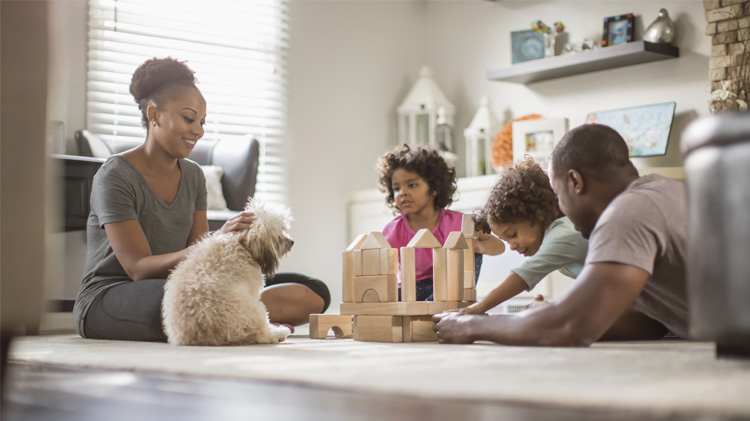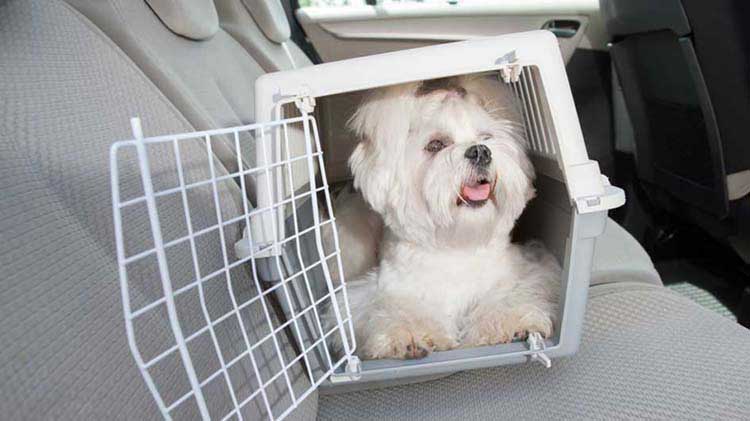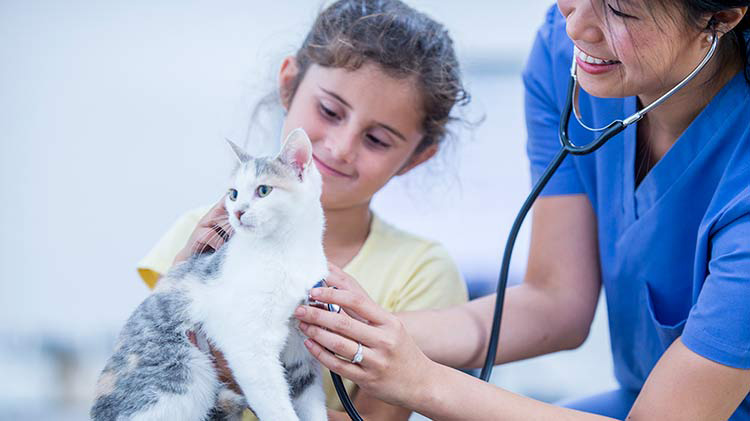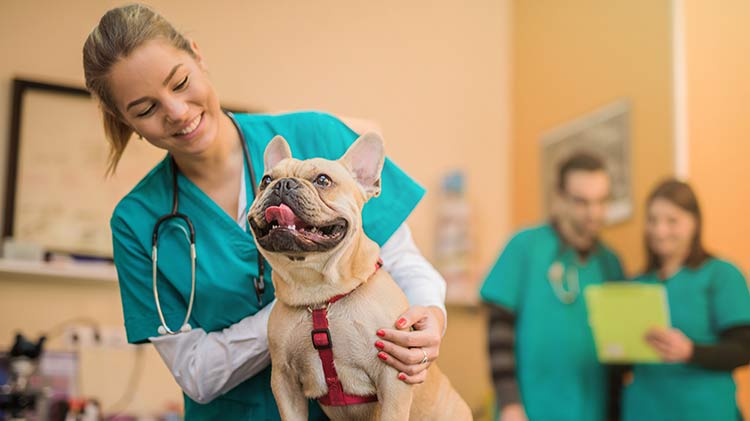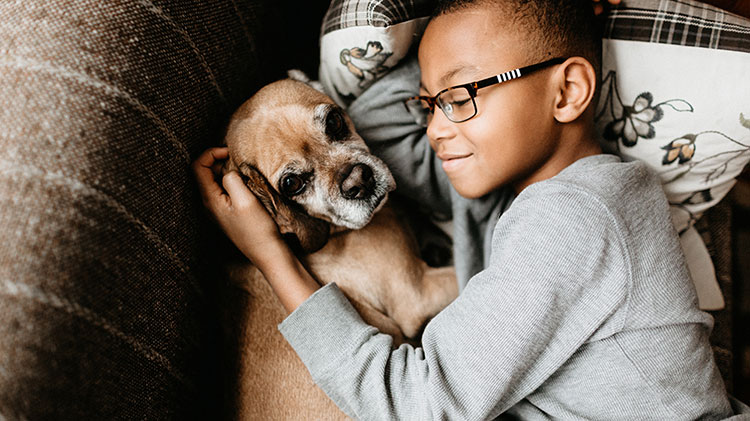Pet hazards
If you take a look around your space, you will likely find household items dangerous for dogs and things toxic to cats. Help protect your pet — before they get into trouble — with these tips.
Raise your hand if your dog or cat follows you into the bathroom, "helps" you cook and fold laundry or nibbles on houseplants. (Yep, ours too.) Some of these behaviors can be endearing — but some veer into dangerous territory. With a little bit of preparation, you can help keep your furry friend safe from pet hazards, even when you can't be there.
Pet hazards in the kitchen
Many cats and dogs are food motivated, and they don't always distinguish between their food and ours. This can be an issue because many human foods are toxic for pets, and some foods are simply a no-no because they can cause blockages, diarrhea or other issues.
Based on information from the American Society for the Prevention of Cruelty to Animals (ASPCA), The Humane Society of the United States and Trupanion, we compiled a list of toxins to pets (or otherwise dangerous) that you may find in your kitchen.
Get a pet insurance quote
Take care of bow-wows and meows.
- Alcohol
- Apple seeds
- Apricot pits
- Avocados
- Bones (can cause a blockage or cut through your pet's digestive tract)
- Caffeine
- Chocolate
- Coffee (both grounds and beans)
- Fruit pits (including cherry and peach pits)
- Garlic
- Grapes
- Gum (can cause blockages and sugar-free gums may contain the toxic sweetener Xylitol)
- Hops (used in brewing beer at home)
- Milk (can lead to digestive upset and diarrhea)
- Moldy foods
- Mushroom plants
- Mustard seeds
- Nicotine (can cause dangerously high heart rate)
- Nuts, including macadamia nuts
- Onions and onion powder (can destroy red blood cells and cause anemia)
- Potato leaves and stems (green parts)
- Raisins
- Rhubarb leaves
- Rich and fatty foods (can cause digestive issues)
- Salt
- Tomato leaves and stems (green parts)
- Xylitol (an artificial sweetener often found in gum, sugar-free candy, certain peanut butters and more)
- Yeast dough
Tips to keep your pet safe in the kitchen:
- A good rule of thumb: Ask your veterinarian before you feed your pet human food — but when in doubt, stick to quality pet food.
- Enclose all food. Keep food off countertops and behind shut doors.
- Use garbage cans with lids that close securely or lock, and keep the lids closed.
- Install child locks on lower cabinet doors.
Pet hazards in living spaces
Where does your pet spend the most time? Probably in the same rooms you do. By taking a look at these spaces from your pet's perspective, you can anticipate (and prevent) safety snafus.
We put together a list of common household items dangerous to dogs and cats with help from The Pet Poison Helpline. Like the foods we listed above, some of the items listed are toxic, while some could cause other blockages or other health issues.
- Batteries
- Certain houseplants, including aloe vera and philodendron
- Prescription drugs and over the counter medicine
- Cleaning supplies
- Laundry detergent
- Dryer sheets
- Toothpaste (can contain Xylitol)
- Kids' toys, especially with small parts and batteries
- Front-loading washers and dyers
- Electric blankets & electrical cords, including phone chargers
Tips to keep your pet safe around the house:
- Check if your houseplants are toxic to your cat or dog. If you can't place toxic plants out of reach, ask friends or family if they'll take your greenery for you.
- Lock up household chemicals. Curious pets may be able to open cabinet doors. Use child-safe locks to prevent access.
- Pick up children's toys. Small parts could be choking hazards, and batteries are toxic if eaten.
- Remove any choking or eating hazards. This is especially important for animals such as dogs and cats that like to chew...on anything. You may find clothing, electronics and shoes present unwanted allure.
- Keep toilet lids closed.
- Store sharp objects, such as razors, up high.
- Close doors on dryers and washers.
- Do not let your pet lay on electric blankets with you. It may cause burns to your pet or cause the blanket to overheat.
- Move or cover electrical cords that could be chewed.
- Confine pets when you're gone. A crate or room that's separated by a gate may be a good solution to ensure your pet feels secure and can't destroy anything in your home, too.
Pet hazards in the garage and yard
It's important to pay attention to the outside of your home, too. We put together a list of outdoor hazards for dogs and cats with help from The Pet Poison Helpline and the ASPCA.
- Antifreeze
- Chemicals
- Fertilizers and herbicides
- Certain plants
Tips to keep your pet safe in the garage and yard:
- Store toxins and sharp tools high up.
- Clean up spilled or leaked antifreeze. Even small amounts are very toxic to animals.
- Unplug and put away any power tools.
- Check and repair fence boards that may be loose.
- Build pet safety into your yard. Guard them from harm by fixing fences and keeping the lawn free of any obstacles or trash.
- Bury chicken wire to prevent pets from digging or escaping under fence boards.
- If you spray the yard with chemicals, fertilizers or herbicides, look for pet-safe options and/or follow manufacturer's directions.
- Check if your outdoor plants are toxic to your cat or dog. If you have toxic plants, place a barrier around them.
- Place barriers around vegetable gardens and open-water areas such as swimming pools.
Pet hazards in the car
If your pet travels in the car with you — even if it's just once a year for a checkup — make sure you're doing everything you can to keep them safe.
Tips to keep your pet safe in the car:
- Keep your pets in a heavy-duty car crate or behind a barrier (separate from you). Having a pet on your lap while driving is not recommended — they're a distraction and at risk.
- Secure your pet with a leash or harness. Protect your pet — and prevent them from running away — in case you're in an accident.
- Road trippin'? Research pet-friendly spots first. Make sure you have plenty of pet-safe stops to let them out (on a leash) for bathroom and exercise breaks.
Bottom line: You can take steps to protect your pet
You can't expect the unexpected — but you can help protect your pet from new and unexpected illnesses and injuries. Discover how a pet insurance policy can be there for your pet during their lifetime. Talk to a State Farm® agent or get a quote online.
Terms and conditions do apply. We love informed decisions. See the Trupanion policy for full coverage details.
